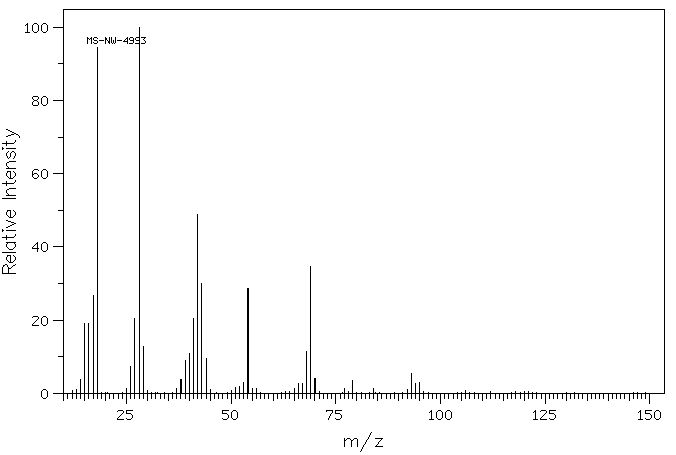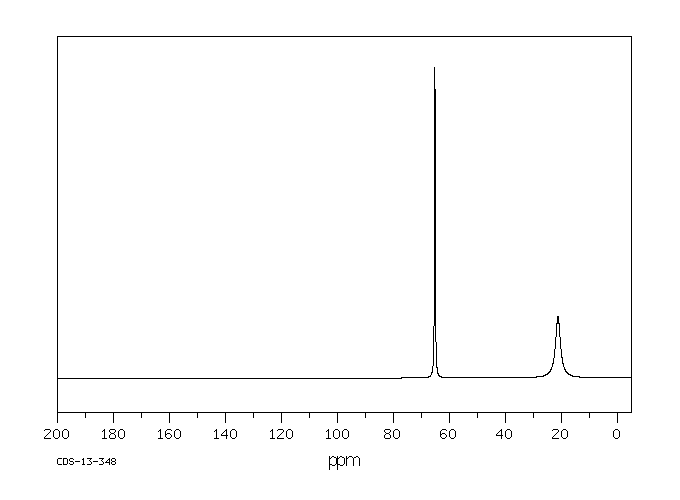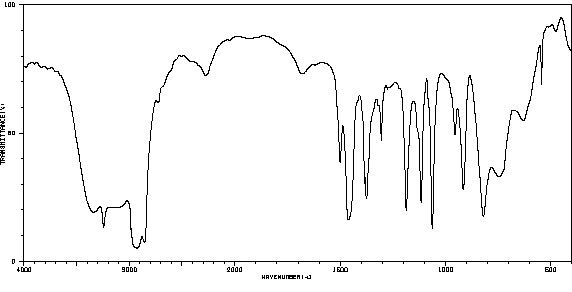2-氨基乙醛 | 75-39-8
中文名称
2-氨基乙醛
中文别名
1-氨基乙醇;胺乙醇;1-胺乙醇;乙醛胺;2-氨乙醛
英文名称
aminoethyl alcohol
英文别名
α-Aminoethanol;acetaldehyde ammonia;monoethanol amine;1-Aminoethanol;ethanol amine;monoaminoethanol
CAS
75-39-8
化学式
C2H7NO
mdl
——
分子量
61.0837
InChiKey
UJPKMTDFFUTLGM-UHFFFAOYSA-N
BEILSTEIN
——
EINECS
——
-
物化性质
-
计算性质
-
ADMET
-
安全信息
-
SDS
-
制备方法与用途
-
上下游信息
-
文献信息
-
表征谱图
-
同类化合物
-
相关功能分类
-
相关结构分类
物化性质
-
熔点:95-97°C (dec.)
-
沸点:109-111°C
-
密度:0.9610 (estimate)
-
物理描述:Acetaldehyde ammonia appears as a white crystalline solid. Melting point 97°C. Boiling point 110°C (with some decomposition). An addition product between acetaldehyde and ammonia. Presents moderate fire and explosion hazard when exposed to heat or flame. Moderately toxic by ingestion and inhalation and a strong irritant. Used to make other chemicals, vulcanize rubber.
计算性质
-
辛醇/水分配系数(LogP):-0.9
-
重原子数:4
-
可旋转键数:0
-
环数:0.0
-
sp3杂化的碳原子比例:1.0
-
拓扑面积:46.2
-
氢给体数:2
-
氢受体数:2
安全信息
-
危险等级:9
-
危险品标志:Xi
-
危险类别码:R36/37/38
-
危险品运输编号:1841
-
包装等级:III
-
危险类别:9
-
安全说明:S26,S36/37/39
-
储存条件:密封、阴凉、干燥处避光保存。
SDS
| Name: | Acetaldehyde ammonia trimer 98% Material Safety Data Sheet |
| Synonym: | Hexahydro-2,4,6-trimethyl-s-triazine trihydrat |
| CAS: | 75-39-8 |
Synonym:Hexahydro-2,4,6-trimethyl-s-triazine trihydrat
Section 2 - COMPOSITION, INFORMATION ON INGREDIENTS
| CAS# | Chemical Name | content | EINECS# |
| 75-39-8 | Acetaldehyde ammonia trimer, 98% | 98% | 200-868-2 |
Risk Phrases: 36/37/38
Section 3 - HAZARDS IDENTIFICATION
EMERGENCY OVERVIEW
Irritating to eyes, respiratory system and skin.The toxicological properties of this material have not been fully investigated.Hygroscopic (absorbs moisture from the air).
Potential Health Effects
Eye:
Causes eye irritation.
Skin:
Causes skin irritation.
Ingestion:
The toxicological properties of this substance have not been fully investigated.
Inhalation:
Causes respiratory tract irritation.
Chronic:
No information found.
Section 4 - FIRST AID MEASURES
Eyes: Immediately flush eyes with plenty of water for at least 15 minutes, occasionally lifting the upper and lower eyelids. Get medical aid immediately.
Skin:
Get medical aid. Flush skin with plenty of water for at least 15 minutes while removing contaminated clothing and shoes.
Ingestion:
If victim is conscious and alert, give 2-4 cupfuls of milk or water.
Never give anything by mouth to an unconscious person. Get medical aid.
Inhalation:
Remove from exposure and move to fresh air immediately. If not breathing, give artificial respiration. If breathing is difficult, give oxygen. Get medical aid.
Notes to Physician:
Section 5 - FIRE FIGHTING MEASURES
General Information:
As in any fire, wear a self-contained breathing apparatus in pressure-demand, MSHA/NIOSH (approved or equivalent), and full protective gear.
Extinguishing Media:
Use water spray, dry chemical, carbon dioxide, or chemical foam.
Section 6 - ACCIDENTAL RELEASE MEASURES
General Information: Use proper personal protective equipment as indicated in Section 8.
Spills/Leaks:
Vacuum or sweep up material and place into a suitable disposal container. Clean up spills immediately, observing precautions in the Protective Equipment section.
Section 7 - HANDLING and STORAGE
Handling:
Avoid breathing dust, vapor, mist, or gas. Avoid contact with skin and eyes. Avoid ingestion and inhalation. Use only in a chemical fume hood.
Storage:
Store in a cool, dry place. Store in a tightly closed container.
Section 8 - EXPOSURE CONTROLS, PERSONAL PROTECTION
Engineering Controls:
Good general ventilation should be sufficient to control airborne levels.
Exposure Limits CAS# 75-39-8: Personal Protective Equipment Eyes: Wear appropriate protective eyeglasses or chemical safety goggles as described by OSHA's eye and face protection regulations in 29 CFR 1910.133 or European Standard EN166.
Skin:
Wear appropriate protective gloves to prevent skin exposure.
Clothing:
Wear appropriate protective clothing to prevent skin exposure.
Respirators:
Follow the OSHA respirator regulations found in 29 CFR 1910.134 or European Standard EN 149. Use a NIOSH/MSHA or European Standard EN 149 approved respirator if exposure limits are exceeded or if irritation or other symptoms are experienced.
Section 9 - PHYSICAL AND CHEMICAL PROPERTIES
Physical State: Solid
Color: very slightly beige
Odor: Not available.
pH: Not available.
Vapor Pressure: Not available.
Viscosity: Not available.
Boiling Point: 110 deg C @ 760.00mm Hg
Freezing/Melting Point: 96 deg C
Autoignition Temperature: Not available.
Flash Point: 55 deg C ( 131.00 deg F)
Explosion Limits, lower: Not available.
Explosion Limits, upper: Not available.
Decomposition Temperature:
Solubility in water:
Specific Gravity/Density:
Molecular Formula: C6H15N3.3H2O
Molecular Weight: 183.26
Section 10 - STABILITY AND REACTIVITY
Chemical Stability:
Stable under normal temperatures and pressures.
Conditions to Avoid:
Incompatible materials, contact with water.
Incompatibilities with Other Materials:
Strong oxidizing agents, strong acids.
Hazardous Decomposition Products:
Carbon monoxide, oxides of nitrogen, carbon dioxide.
Hazardous Polymerization: Has not been reported.
Section 11 - TOXICOLOGICAL INFORMATION
RTECS#:
CAS# 75-39-8 unlisted.
LD50/LC50:
Not available.
Carcinogenicity:
Acetaldehyde ammonia trimer, 98% - Not listed by ACGIH, IARC, or NTP.
Section 12 - ECOLOGICAL INFORMATION
Section 13 - DISPOSAL CONSIDERATIONS
Dispose of in a manner consistent with federal, state, and local regulations.
Section 14 - TRANSPORT INFORMATION
IATA
Shipping Name: ACETALDEHYDE AMMONIA
Hazard Class: 9
UN Number: 1841
Packing Group: III
IMO
Shipping Name: ACETALDEHYDE AMMONIA
Hazard Class: 9
UN Number: 1841
Packing Group: III
RID/ADR
Not regulated as a hazardous material.
Section 15 - REGULATORY INFORMATION
European/International Regulations
European Labeling in Accordance with EC Directives
Hazard Symbols: XI
Risk Phrases:
R 36/37/38 Irritating to eyes, respiratory system
and skin.
Safety Phrases:
S 26 In case of contact with eyes, rinse immediately
with plenty of water and seek medical advice.
S 37/39 Wear suitable gloves and eye/face
protection.
WGK (Water Danger/Protection)
CAS# 75-39-8: No information available.
Canada
None of the chemicals in this product are listed on the DSL/NDSL list.
CAS# 75-39-8 is not listed on Canada's Ingredient Disclosure List.
US FEDERAL
TSCA
CAS# 75-39-8 is not listed on the TSCA inventory.
It is for research and development use only.
SECTION 16 - ADDITIONAL INFORMATION
N/A
制备方法与用途
反应信息
-
作为反应物:参考文献:名称:Solvent effects on equilibria of addition of nucleophiles to acetaldehyde and the hydrophilic character of diols摘要:DOI:10.1021/ja00343a044
-
作为产物:参考文献:名称:Solvent effects on equilibria of addition of nucleophiles to acetaldehyde and the hydrophilic character of diols摘要:DOI:10.1021/ja00343a044
-
作为试剂:参考文献:名称:Synthesis, Biological Evaluation and Structure-Activity Relationships of New Quinoxaline Derivatives as Anti-Plasmodium falciparum Agents摘要:我们报道了十八种喹喔啉和喹喔啉1,4-双-N-氧化物衍生物的合成及其抗疟活性,其中八种是完全新颖的。化合物1a和2a对恶性�隆疟原虫株表现出最强的活性。结构-活性关系表明,与喹喔啉环相连的烯酮部分的重要性。DOI:10.3390/molecules19022166
文献信息
-
Synthesis of naphthazarin derivatives and identification of novel thioredoxin reductase inhibitor as potential anticancer agent作者:Junmin Zhang、Yaping Liu、Danfeng Shi、Guodong Hu、Baoxin Zhang、Xinming Li、Ruijuan Liu、Xiao Han、Xiaojun Yao、Jianguo FangDOI:10.1016/j.ejmech.2017.09.027日期:2017.11drug targets. We report here the synthesis of a panel of naphthazarin derivatives and discovery of 2-methyl-5,8-dihydroxy-1,4-naphthoquinone (3, 2-methylnaphthazarin) as a potent cytotoxic agent with a submicromolar half maximal inhibitory concentration to the human promyelocytic leukemia HL-60 cells. Mechanism studies reveal that the compound selectively inhibits TrxR to induce oxidative stress-mediated哺乳动物的硫氧还蛋白还原酶(TrxR)酶在调节多个基于氧化还原的信号通路中起着至关重要的作用,作为有希望的抗癌药物靶点,引起了越来越多的关注。我们在这里报告萘茜衍生物的面板和2-甲基-5,8-二羟基-1,4-萘醌(发现的合成3,2-methylnaphthazarin)为具有亚微摩尔的半数最大抑制浓度的一种有效的细胞毒性剂人早幼粒细胞白血病HL-60细胞。机制研究表明,该化合物选择性抑制TrxR,以诱导氧化应激介导的HL-60细胞凋亡。敲低TrxR可使细胞敏感至3侮辱,虽然功能性酶的过表达赋予了对化合物治疗的抗性,但仍以3为靶标来支持TrxR的生理学意义。化合物3与TrxR的相互作用的澄清揭示了该化合物的细胞作用的基础机理,并且在考虑将化合物开发为潜在的癌症化学治疗剂方面提供了启示。
-
Tyrosinase and catecholase-like activities of a dinuclear Cu(II) complex作者:Arnab Chatterjee、Hare Ram Yadav、Angshuman Roy Choudhury、Anzar Ali、Yogesh Singh、Rajarshi GhoshDOI:10.1016/j.poly.2017.11.040日期:2018.2interaction. The compound was found to be tyrosinase and catecholase active. In case of tyrosinase activity, the diphenol formed was isolated using thin layer chromatography (TLC) and characterized through 1H NMR as well as mass spectrometry. The o-quinone derivative formed in this reaction was characterized using GC–MS. The latter activity was monitored spectrophotometrically and the product o-quinone derivative
-
Synthesis of 1,3-oxazino(5,6-c)isoquinolines and related compounds.作者:MIYOKO TOYAMA、HIROTAKA OTOMASUDOI:10.1248/cpb.33.5543日期:——Mannich reaction of 1-chloro-4-isoquinolinol (1) with dimethylamine and formalin afforded the base, 1-chloro-3-dimethylaminomethyl-4-isoquinolinol (2), and a by-product, 1, 1'-dichloro-3, 3'-methylenedi-4-isoquinolinol (3). The reaction of 1 with formalin in H2SO4 gave 6-chloro-1, 3-dioxino [5, 6-c] isoquinoline (4). The reactions of 1 with formalin and primary amines, and of 1 with acetaldehyde ammonia afforded the corresponding products, 1, 3-oxazino [5, 6-c] isoquinolines (5-7), in fair yields. Methyl 4-hydroxy-1-oxo-1, 2-dihydroisoquinoline-3-carboxylate (8) was converted into the carboxamide (9), which, on heating with a mixture of POCl3 and PCl5, afforded two chloro-cyano compounds 10 and 11 in a ratio of ca. 1 : 2. The reaction of 11 with hydrazine hydrate gave the 1-hydrazino compound (13).1-氯-4-异喹啉醇(1)与二甲胺和福尔马林发生曼尼希反应,生成了碱性产物1-氯-3-二甲氨基甲基-4-异喹啉醇(2)和一种副产物1,1'-二氯-3,3'-亚甲基二-4-异喹啉醇(3)。将1与福尔马林在硫酸(H2SO4)中反应得到6-氯-1,3-二氧杂-[5,6-c]异喹啉(4)。1与福尔马林和初级胺反应,以及1与乙醛氨反应,分别获得相应的产物1,3-噁唑基-[5,6-c]异喹啉(5-7),产率较好。4-羟基-1-氧-1,2-二氢异喹啉-3-羧酸甲酯(8)被转化为羧酰胺(9),在POCl3和PCl5混合物加热下,生成了两种氯氰化合物10和11,比例约为1:2。11与水合肼反应得到1-肼基化合物(13)。
-
One-step synthesis of nitriles by the dehydrogenation–amination of fatty primary alcohols over Cu/m-ZrO2作者:Yunfeng Hu、Shuhan Jin、Zhichao Zhang、Likun Zhang、Jun Deng、Hongsheng ZhangDOI:10.1016/j.catcom.2014.05.010日期:2014.9An effective method for one-step synthesis of nitriles employing C2–C8 fatty primary alcohols and ammonia over 5%Cu/m-ZrO2 has been found. The conversion of alcohols and selectivity of nitriles obtained are > 96 and > 87 wt.%, respectively, and are obviously influenced by the C2-substitution rather than the chain length of fatty primary alcohols. Cu/m-ZrO2 was characterized by XRD, H2-TPR, CO2-TPD
-
一种含多羟基的三嗪环成碳剂的制备方法申请人:南京林业大学公开号:CN106045928A公开(公告)日:2016-10-26
表征谱图
-
氢谱1HNMR
-
质谱MS
-
碳谱13CNMR
-
红外IR
-
拉曼Raman
-
峰位数据
-
峰位匹配
-
表征信息
同类化合物
(乙腈)二氯镍(II)
(R)-(-)-α-甲基组胺二氢溴化物
(N-(2-甲基丙-2-烯-1-基)乙烷-1,2-二胺)
(4-(苄氧基)-2-(哌啶-1-基)吡啶咪丁-5-基)硼酸
(11-巯基十一烷基)-,,-三甲基溴化铵
鼠立死
鹿花菌素
鲸蜡醇硫酸酯DEA盐
鲸蜡硬脂基二甲基氯化铵
鲸蜡基胺氢氟酸盐
鲸蜡基二甲胺盐酸盐
高苯丙氨醇
高箱鲀毒素
高氯酸5-(二甲氨基)-1-({(E)-[4-(二甲氨基)苯基]甲亚基}氨基)-2-甲基吡啶正离子
高氯酸2-氯-1-({(E)-[4-(二甲氨基)苯基]甲亚基}氨基)-6-甲基吡啶正离子
高氯酸2-(丙烯酰基氧基)-N,N,N-三甲基乙铵
马诺地尔
马来酸氢十八烷酯
马来酸噻吗洛尔EP杂质C
马来酸噻吗洛尔
马来酸倍他司汀
顺式环己烷-1,3-二胺盐酸盐
顺式氯化锆二乙腈
顺式吡咯烷-3,4-二醇盐酸盐
顺式双(3-甲氧基丙腈)二氯铂(II)
顺式3,4-二氟吡咯烷盐酸盐
顺式1-甲基环丙烷1,2-二腈
顺式-二氯-反式-二乙酸-氨-环己胺合铂
顺式-二抗坏血酸(外消旋-1,2-二氨基环己烷)铂(II)水合物
顺式-N,2-二甲基环己胺
顺式-4-甲氧基-环己胺盐酸盐
顺式-4-环己烯-1.2-二胺
顺式-4-氨基-2,2,2-三氟乙酸环己酯
顺式-3-氨基环丁烷甲腈盐酸盐
顺式-2-羟基甲基-1-甲基-1-环己胺
顺式-2-甲基环己胺
顺式-2-(苯基氨基)环己醇
顺式-2-(苯基氨基)环己醇
顺式-2-(氨基甲基)-1-苯基环丙烷羧酸盐酸盐
顺式-1,3-二氨基环戊烷
顺式-1,2-环戊烷二胺二盐酸盐
顺式-1,2-环戊烷二胺
顺式-1,2-环丁腈
顺式-1,2-双氨甲基环己烷
顺式--N,N'-二甲基-1,2-环己二胺
顺式-(R,S)-1,2-二氨基环己烷铂硫酸盐
顺式-(2-氨基-环戊基)-甲醇
顺-2-戊烯腈
顺-1,3-环己烷二胺
顺-1,3-双(氨甲基)环己烷









